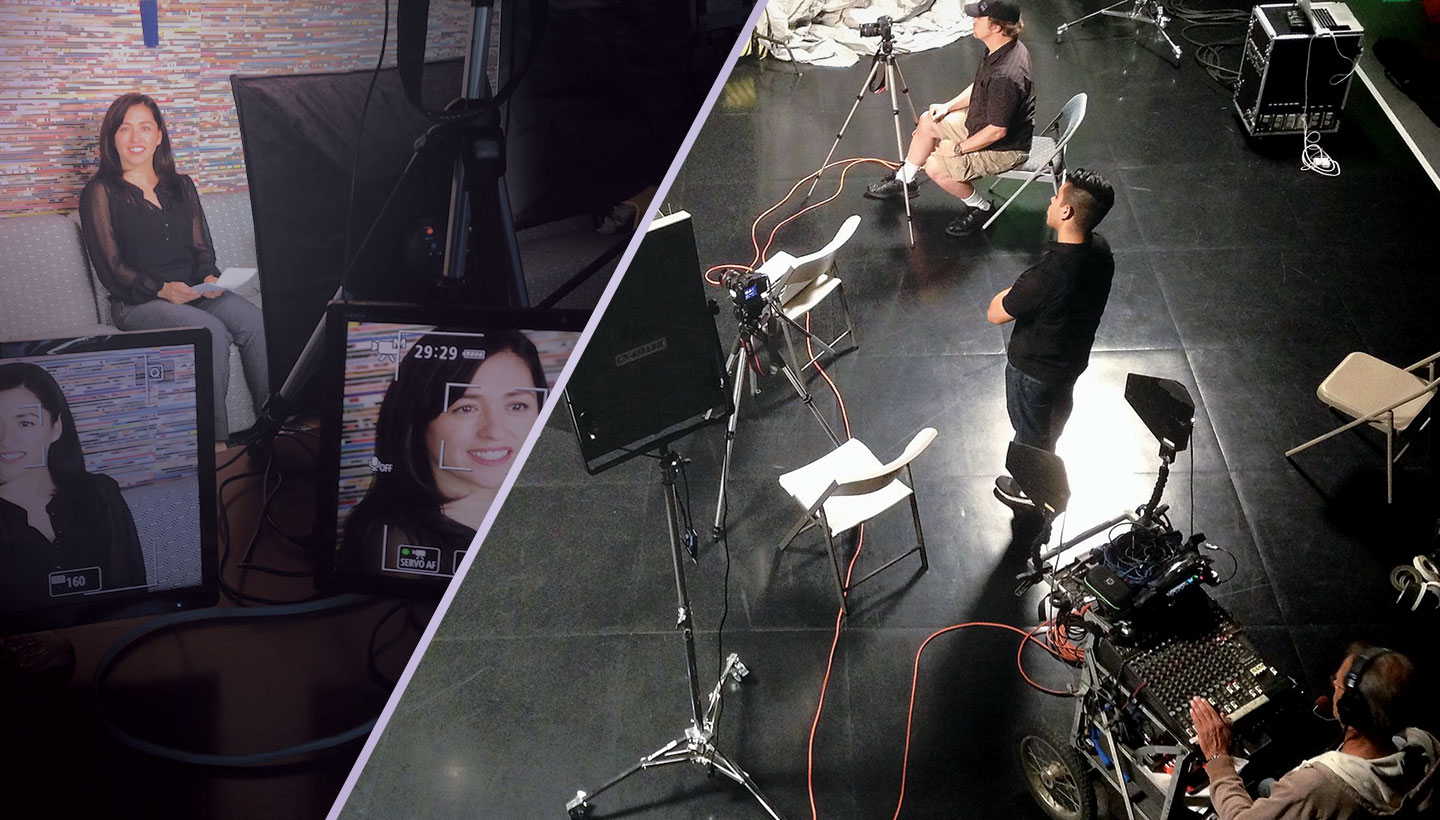
Jeff Nicosia, owner and founder of Industrious Films, will be the first to tell you that his company of creatives is typical of the new, modern creative agency. They make their name and reputation every day by delivering big advertising agency creative services directly to clients without all the extra expense of big advertising agency overhead and excess.
Part of this lighter approach includes taking a more flexible attitude towards building their team. With decades of experience at some of the best-known agencies in LA and New York, Industrious Films knows that the best people for their projects are spread out all over the country, so they employ a distributed set of creatives on almost every job.
But with entire teams working remotely, they need tools that boost collaboration and reduce the inefficiency of sending huge media files back and forth as everyone pushes to meet client delivery deadlines.
Backblaze hired Industrious Films to produce videos for our NAB booth presence last year, and during our collaborative process we introduced Backblaze B2 Cloud Storage to their team. For this group of road-tested veterans, the potential for our cloud storage project to help their process was eye-opening indeed.
How Cloud Storage Has Impacted Industrious Films Workflow
As we re-engaged with Industrious Films to work on new projects this year, we wanted to hear Jeff’s thoughts on what cloud storage has accomplished for his team, and what it was like before they started using B2.

Skip Levens: Jeff, can you tell me about the niche that Industrious Films has carved out, and what your team is like?
Jeff Nicosia: Industrious Films brings the best of advertising agency video production directly to companies by eliminating the middleman. We tell customer and company stories really well, with craft, and have found a way to do it at a price that lets companies do a lot more video in their marketing vs. a once-a-year luxury. We’ve really found our niche in telling company stories and customer videos, working for companies like Quantum, Backblaze (of course), DDN, Thanx, Unisan, ExtraHop and tons more.
We’re all creatives that worked at ad agencies, design studios, post houses, etc. We’re spread out but come together for projects all over the country, and actually the world. Right now I’m in Manhattan Beach (Los Angeles, CA) while our main editor is on the other side of LA—25 minutes or 2 hours by car away depending on time of day—and our main graphics editor is in Iowa. Oh, and our colorist is either in Los Angeles or Brazil, depending on the time of year.
As for shooting we use sound guys, shooters, PA’s, etc., either from LA, or we hire locally wherever we’re shooting the video. We have crews we have collaborated with on multiple occasions in LA, Seattle, New York, London, and San Francisco. I actually shot a timelapse of a fairly typical shoot day: “A 14-Hour Shoot in 60s” to give you an idea of what it’s like.
SL: Jeff, before we talk about how you adopted Backblaze B2 and cloud storage in general, can you paint a picture of what it’s usually like to shoot and deliver a large video project like the one you created for us?
JN: It’s a never-ending exchange of hard drives and bouncing between Dropbox, Box, Google Drive, and what have you, as everyone is swapping files and sending updates. We’re also chasing customers and asking, “Did you get the file?” Or, “Did you send the file?” All of this was hard enough when video size was HD—now, when everything’s 4K or higher it just doesn’t work at all. A single 4K RAW file of 3-4GB might take up an entire Google Drive allowance, and it gets very expensive to save to Google Drive beyond that size. We’ve spent an entire day trying to upload a single critical file that looks like its uploading, then have it crap out hours later. At that point, we’ve just wasted a day and we’re back to slapping files on a hard drive and trying to make the FedEx cutoff.
“Any small business or creative endeavor has to be remote nowadays. You want to hire the best people, no matter where they are. When people live where they want and work out of a home office they charge less for their rates—that’s how we deliver a full-service ad agency and video production service at the prices we can.”
SL: I remember, from working together on other projects, that we were constantly swapping hard drives and saying, “Is this one yours?” Or finally seeing you again years later, and handing you back your hard drive.
JN: Right! It’s so common. And you can’t just put files on a hard drive and ship it. We’ve had overnight services lose drives on us enough times that we’ve learned to always make extra copies on entirely new hard drives before sending a drive out. It’s always a time crunch and you have to make sure you have a spare drive and that it’s big enough. And you just know that when you send it to a client you’re never going to see that drive again. It’s a cost of business, and hundreds of dollars a month just gone—or at least it used to be. I’ve spent way too much time stalking Best Buy buying extra hard drives when there’s a sale because we were constantly buying drives.
SL: So that was the mindset when we kicked off our NAB Video Project last year (for NAB 2019) and I said, instead of handing you a hard drive with all of our B-roll, logos, etc., let’s use Backblaze B2.
Technical Note: I helped Industrious Films set up three buckets: a private bucket that I issued write-only app keys for (basically a ‘drop bucket’ for any incoming content); a private bucket for everyone on the project to access; and a public bucket for sharing review files directly from Backblaze if needed.
Next, I cut app keys for Industrious Films that spanned all three buckets so that they could easily organize and rearrange content as needed. I entered the app key into a bookmark in Cyberduck, and gave Industrious Films the bookmark to drop into Cyberduck.

JN: Well, we work for technical clients, but I’m not really a technical guy. And my team are all creatives, not techies, so anything we use has to be incredibly simple. I wasn’t sure how it was going to work. Most of us were familiar with FTP clients, and this interface looks like the files and folders we’d see on a typical shared storage server, so it was very easy to adapt.
“Even though I have a background in tech, I’ve worked in technology companies, and my customers are tech companies, I’m not a tech savvy guy at all and I don’t want to be. So the tools I use have to be simple and let me get on with telling my customer’s story.”
Everyone on my team works out of their home offices, or shared workspaces. I’ve got a 100 Megabit connection, up and down, and our graphics guy has the same—and he’s in the middle of Iowa. We each started uploading files in Cyberduck, then we jumped on a Skype call together and watched 6GB files fly across and we were just blown away. We just couldn’t believe that this was cloud storage, and it seemed like the more we put in, the faster it got. Our graphics guy was just raving about it, trying out bigger and bigger file uploads. He was freaking out—he kept saying, “What kind of secret sauce do these guys have!?”
SL: Can you tell me how the team adjusted to using a shared bucket? What did collaboration look like?
JN: First of all, since we had a files and folders interface, I jumped right in and did the usual organization of assets. One folder for Backblaze customer video reels, one for Backblaze B-roll, one for logos, one for audio, one for storyboards, motion graphics templates, etc. Then everyone downloads what they need from the folder to work locally, and puts changed and finished files back up in the shared bucket for everyone to see. That way we can review on the fly.
I sync everything to a local RAID array, but most of the time my focus is only on the shared bucket with the team. I don’t use an asset manager or project manager solution—I can always drop in something like iconik later if we’re doing overlapping large projects simultaneously. This works for our team for now and is exactly what we need.
“My graphics lead moved from North Hollywood to Iowa. And whether he’s 25 miles away from me or 2000, if we’re not in the same room, we need a way to send files to each other quickly to work together. So if the tools are good enough, it doesn’t matter where the team is anymore.”

SL: I seem to remember we needed some of those files for tweaks and changes as we were deploying on the NAB show floor?
JN: Right, since we had the entire project and all the source files online, in all the chaos of NAB booth building before the show opened, as we played our video on the huge screens—we realized we could still swap in a better graphic. So, we just pulled from the Backblaze web interface and dropped it in right there. Otherwise, we’d have had to track down the new file and have someone deliver it to us, or more likely not make the change at all.
“Speed is collaboration for us as a small team. When uploads and downloads are fast and we’re not fighting to move files around, then we can try new ideas quickly, zero in on the best approach, and build and turn projects faster. It’s how we punch way, way above our weight as a small shop and compete with the biggest agencies.”
SL: What advice would you give creatives who want to try to rely less on dragging hard drives around? Any final thoughts?
A: Well, first of all, hard drives are never totally going away. At least not until something very simple and very cheap comes along. I might work for technical customers, but sometimes their marketing leads will hand me hard drives, or when I want to deliver a file or have them review a file they’ll ask me to put it on a private YouTube or Vimeo link. They want to review on their phone or at lunch, so it needs to be simple for them, too. But at least we can organize everything we do on Backblaze and there’s a lot fewer hard drives in my life at least.
One of the biggest revelations I’ve had is not just for editors and producers working on projects like we did, but for shooters too. On a shoot, everyone takes a copy of the raw files and no one leaves the shoot until there are two copies. If there’s a problem with the camera carts (storage cards) this whole process can be agonizingly slow. If only more people knew they could upload a copy to something like Backblaze that would not only function as a shared copy but also allow everyone to start reviewing and editing files right away instead of waiting until they got back to the shop.
And finally, everyone can do what we’ve done. The way we’ve thrived and how creatives find their niche and thrive in a gig economy is to use simple, easy to use tools that let you tell those stories, offer better service, and compete with bigger agencies with higher overhead. We did it, anyone else can too.
SL: Absolutely! Thanks Jeff, for taking time out to talk to us. We really appreciate your team’s work and look forward to working together on our next project!





